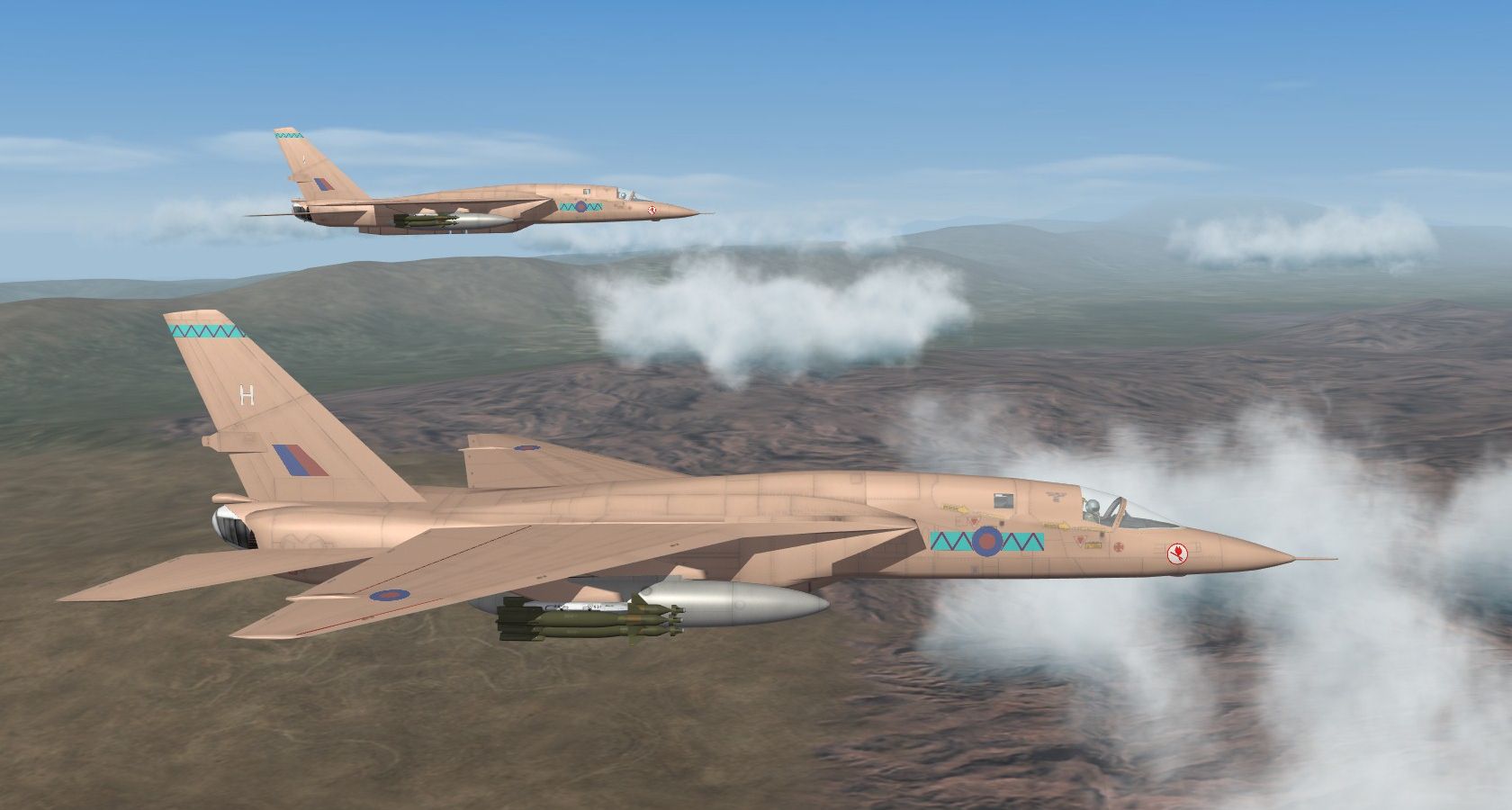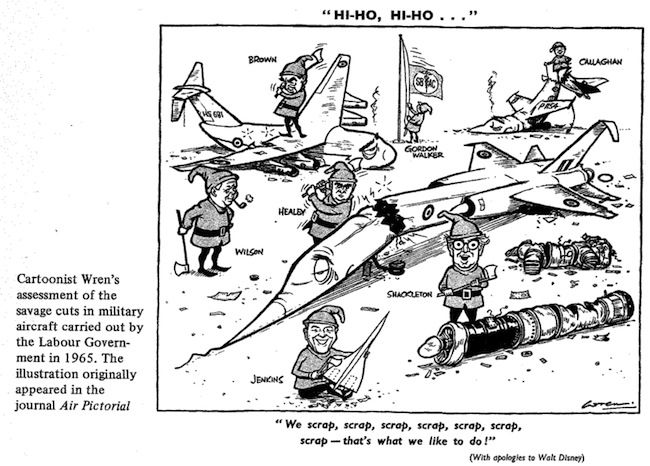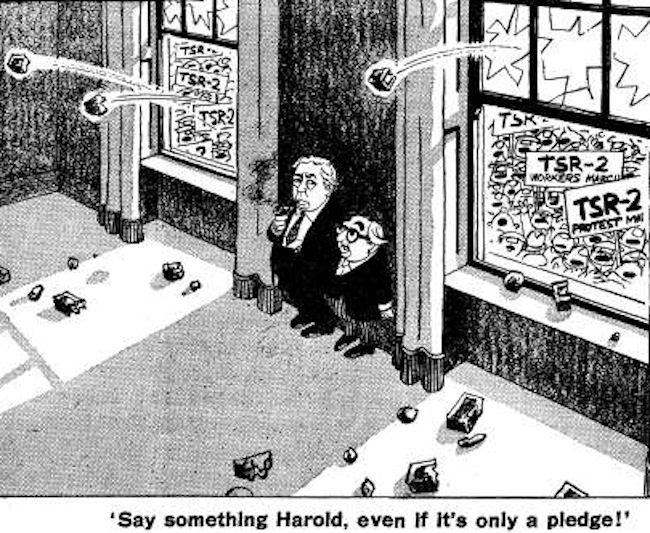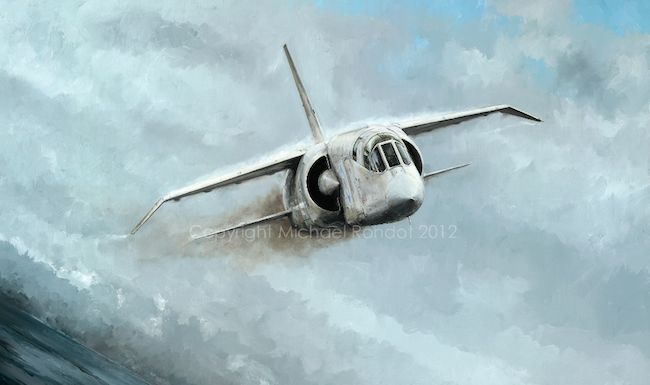1968...what would you do differently?
Join Date: Oct 2007
Location: netherlands
Age: 56
Posts: 769
Likes: 0
Received 0 Likes
on
0 Posts
Re: TRS2
I don't see much space to put fuel other then behind the cockpit. Probably there would have been many tankers all around and very efficient engines.
http://cdn-www.airliners.net/aviatio.../9/0979919.jpg
Wait a few yrs for F15s / F14s ? With Spey's 
I don't see much space to put fuel other then behind the cockpit. Probably there would have been many tankers all around and very efficient engines.
http://cdn-www.airliners.net/aviatio.../9/0979919.jpg
1968...what would you do differently?

I don't see much space to put fuel other then behind the cockpit.
After devouring ORAC's link yesterday and learning a lot about TSR2 that I did not know before, a few observations...
Cost was wildly underestimated, as with TFX and JSF. Paddy Hine, in his what-if musings about what might have been if the project continued, doubts that more than 100 would have been affordable, and that high-end estimates would have precluded the F-4K program.
The overruns were being under-reported (see Wilson's comments, p16 on) and the communications between MoA/S, MoD, prime, subs and direct-to-government suppliers were rife with suppression and misinformation. ACAS(OR) was ready to scrap the project before the Oct 64 election because costs were out of control.
The airframe and engine would probably have come good, eventually - but two requirements in particular (M=2.25 vs M=1.7, and STOL/grass field) were very expensive and had been imposed without a proper cost study. As one participant remarks, there was nobody in industry to say "you can't have that". (cough TFX JSF cough)
Avionics? This would make a fascinating comparison with F-111 experience, and to consider whether TSR2 was more equivalent to the original F-111A kit, the never-worked F-111D system or the compromise Mk IIB that the C/E/F all had. It sounds a bit like -111D in which case it would be a freaking nightmare. Also, as Simmons (p107 on) notes, the best accuracy in a low-level blind delivery was several hundred yards - so the concept depended on a sizable arsenal of kiloton bombs, which nobody was signing up for in 1964-65.
With a Pave Tack equivalent and a 1980s avionics modernization, it would have been different, but until then...
Technologically, a great deal was learned. From a requirements viewpoint, one result was a more balanced set of reqs for MRCA-75/Tornado, and even Typhoon. It's interesting that while the UK/Europe have had their difficulties, it is the US where death by compounded requirements has been the rule - B-1A, B-2, F-22 and JSF.
Cost was wildly underestimated, as with TFX and JSF. Paddy Hine, in his what-if musings about what might have been if the project continued, doubts that more than 100 would have been affordable, and that high-end estimates would have precluded the F-4K program.
The overruns were being under-reported (see Wilson's comments, p16 on) and the communications between MoA/S, MoD, prime, subs and direct-to-government suppliers were rife with suppression and misinformation. ACAS(OR) was ready to scrap the project before the Oct 64 election because costs were out of control.
The airframe and engine would probably have come good, eventually - but two requirements in particular (M=2.25 vs M=1.7, and STOL/grass field) were very expensive and had been imposed without a proper cost study. As one participant remarks, there was nobody in industry to say "you can't have that". (cough TFX JSF cough)
Avionics? This would make a fascinating comparison with F-111 experience, and to consider whether TSR2 was more equivalent to the original F-111A kit, the never-worked F-111D system or the compromise Mk IIB that the C/E/F all had. It sounds a bit like -111D in which case it would be a freaking nightmare. Also, as Simmons (p107 on) notes, the best accuracy in a low-level blind delivery was several hundred yards - so the concept depended on a sizable arsenal of kiloton bombs, which nobody was signing up for in 1964-65.
With a Pave Tack equivalent and a 1980s avionics modernization, it would have been different, but until then...
Technologically, a great deal was learned. From a requirements viewpoint, one result was a more balanced set of reqs for MRCA-75/Tornado, and even Typhoon. It's interesting that while the UK/Europe have had their difficulties, it is the US where death by compounded requirements has been the rule - B-1A, B-2, F-22 and JSF.
Join Date: Dec 2006
Location: UK
Posts: 799
Likes: 0
Received 0 Likes
on
0 Posts
LO,
Your point about over-specification and compounded requirements is well made, but I'd respectfully suggest, having been very familiar with them, that JSF requirements were not as 'off beam' as those for F-22 and B-2.
The JORD/JIRD process used for JSF was exhaustive and ran for around three to four years, where any number of trade studies were conducted to ensure that the 'unguided requirement' scenario was less likely to arise.
The JSF programme's main problem, in my view (and others will differ) was a lack of systems engineering discipline in the early days after contract award, which led to requirements not being correctly 'decomposed' or flowed down into the design teams. The main reason for this (again my view) was an extremely optimistic schedule that put the designers under huge time pressure right from the start.
On top of that there was a lack of focus on weight (very regrettable on a powered lift aircraft, and another systems engineering failure) and an over-emphasis on manufacturing (which led in many cases to weight growth).
The other thing to remember about JSF/F-35 is that it is (quite rightly) being fully reported in an open press. Programmes such as F-22, Typhoon, B-2 and many others were quite successful in hiding their problems.
Please note that I'm not denying F-35 has problems and challenges. It does and they are significant. But a bit of perspective might help.
Best Regards as ever
Engines
Your point about over-specification and compounded requirements is well made, but I'd respectfully suggest, having been very familiar with them, that JSF requirements were not as 'off beam' as those for F-22 and B-2.
The JORD/JIRD process used for JSF was exhaustive and ran for around three to four years, where any number of trade studies were conducted to ensure that the 'unguided requirement' scenario was less likely to arise.
The JSF programme's main problem, in my view (and others will differ) was a lack of systems engineering discipline in the early days after contract award, which led to requirements not being correctly 'decomposed' or flowed down into the design teams. The main reason for this (again my view) was an extremely optimistic schedule that put the designers under huge time pressure right from the start.
On top of that there was a lack of focus on weight (very regrettable on a powered lift aircraft, and another systems engineering failure) and an over-emphasis on manufacturing (which led in many cases to weight growth).
The other thing to remember about JSF/F-35 is that it is (quite rightly) being fully reported in an open press. Programmes such as F-22, Typhoon, B-2 and many others were quite successful in hiding their problems.
Please note that I'm not denying F-35 has problems and challenges. It does and they are significant. But a bit of perspective might help.
Best Regards as ever
Engines
Last edited by Engines; 30th Dec 2012 at 13:57. Reason: Spell check
Ecce Homo! Loquitur...
Avionics? This would make a fascinating comparison with F-111 experience

See especially sections 3.6 and 3.8.
The BAC TSR2 – a historic overview from a personal perspective, by Ken Weaver
Join Date: Apr 2010
Location: London
Posts: 7,072
Likes: 0
Received 0 Likes
on
0 Posts
We should have canceled TSR-2, bought off the shelf Phantoms with none of that nonsense about RR re-engining and forced the RAF to accept Buccaneers in 1968
That would have given us a workable, reasonably modern and effective airforce at relatively low cost
That would have given us a workable, reasonably modern and effective airforce at relatively low cost
Join Date: Oct 2007
Location: netherlands
Age: 56
Posts: 769
Likes: 0
Received 0 Likes
on
0 Posts
Stumbled over this picture. Do not know if it was really considered at the time.

Fully production ready, add Olympus engines, UK avionics..
http://upload.wikimedia.org/wikipedi...VAH-7_1979.jpg

Fully production ready, add Olympus engines, UK avionics..
http://upload.wikimedia.org/wikipedi...VAH-7_1979.jpg
Join Date: Apr 2010
Location: London
Posts: 7,072
Likes: 0
Received 0 Likes
on
0 Posts
one of the most beautiful planes ever built IMHO - but heavy on maintenance I believe
And for Gods sake get away from the "upgrade" with British kit - it always cost a fortune and rarely worked (see F-4K etc)
And for Gods sake get away from the "upgrade" with British kit - it always cost a fortune and rarely worked (see F-4K etc)
The A-5 was designed for a very different application to the TSR2! With considerably more wing area than the latter (perhaps even enough for you, JF  ?), for maximum performance at extreme altitude (52 years ago, an early production aircraft attained 91446 ft with a 2200 lb payload....), its low level speed was restricted by structural limitations.
?), for maximum performance at extreme altitude (52 years ago, an early production aircraft attained 91446 ft with a 2200 lb payload....), its low level speed was restricted by structural limitations.
Bravely flown in Viet Nam flying hazardous recce missions, some 18 were lost in combat and more in operational accidents.
Not really a contender for GOR.339. Nice picture though.
 ?), for maximum performance at extreme altitude (52 years ago, an early production aircraft attained 91446 ft with a 2200 lb payload....), its low level speed was restricted by structural limitations.
?), for maximum performance at extreme altitude (52 years ago, an early production aircraft attained 91446 ft with a 2200 lb payload....), its low level speed was restricted by structural limitations. Bravely flown in Viet Nam flying hazardous recce missions, some 18 were lost in combat and more in operational accidents.
Not really a contender for GOR.339. Nice picture though.
Join Date: Dec 2006
Location: UK
Posts: 799
Likes: 0
Received 0 Likes
on
0 Posts
Definitely a beautiful aircraft but.....
the Vigilante had a severe problem with releasing weapons from its 'interesting' weapons bay located lengthwise between the engines. Bombs were to be ejected aft out of the bay, attached to disposable fuel tanks. During trials, stores jammed half in and half out, stuck between the jet pipes, or the tanks burst (leading to one aircraft being lost). These problems were so insoluble that the attack variant never entered service, and the aircraft were converted to the RA-5 variant.
There were also problems with the avionics fit as well as the complex airframe and systems. It was, by all accounts, an extremely challenging aircraft to land back on to carriers.
Best Regards as ever to all
Engines
the Vigilante had a severe problem with releasing weapons from its 'interesting' weapons bay located lengthwise between the engines. Bombs were to be ejected aft out of the bay, attached to disposable fuel tanks. During trials, stores jammed half in and half out, stuck between the jet pipes, or the tanks burst (leading to one aircraft being lost). These problems were so insoluble that the attack variant never entered service, and the aircraft were converted to the RA-5 variant.
There were also problems with the avionics fit as well as the complex airframe and systems. It was, by all accounts, an extremely challenging aircraft to land back on to carriers.
Best Regards as ever to all
Engines
I've often wondered what it would've been like for the crew of a TSR.2 blatting along very fast and very low in turbulent conditions. The cockpit seems to be a long way from the centre of pressure - I think it may have been like riding along on the front of a springboard.
Ecce Homo! Loquitur...
I have a print of a pair of TSR2 in RAF markings flying down a glen currently hanging on my sister's wall. Why, you might ask, on my sister's wall, when she has no great interest in aircraft?
A more familial connection. My father worked on the design of the TSR2 electrical generator system. Which, with yearly trips to Farnborough etc, is where interest in scary planes started....
A more familial connection. My father worked on the design of the TSR2 electrical generator system. Which, with yearly trips to Farnborough etc, is where interest in scary planes started....
I've often wondered what it would've been like for the crew of a TSR.2 blatting along very fast and very low in turbulent conditions.
Engines - Good points, but what I was thinking of was the original decision to build three versions around basically common requirements, with specific deltas on internal weapon size, range &c, and a common OML.
I don't think that the cost (in money and compromised performance) or risk of this approach were appreciated before 1996 - and at that point, all the CAIV in the world was only going to nibble at the ankles of the problem.
For instance, I don't think anyone thought that the JSF engine would weigh 1700 lb more than a brace of F414s, and be more expensive.
Now one might argue that the STOVL option is worth all this... but my point is that the cost was underestimated at the time.
And while the sacrifice of weight to manufacturabiliity in the 2002 design was there, the FW team had been firmly told to keep the cost down.
And the Viggie: fascinating machine, hated and feared by many including the pilots flying "escort" on a brute that would outrun them, leaving them to face the SA-2s that the NVs had aimed at the Viggie. Designed to launch at zero WOD, on the grounds that nuclear retailiation could not wait for the carrier to get moving.
And there was one version of the airplane on which the rear-ejected bomb worked well, as I can confirm from first-hand experience at the age of 8...

I don't think that the cost (in money and compromised performance) or risk of this approach were appreciated before 1996 - and at that point, all the CAIV in the world was only going to nibble at the ankles of the problem.
For instance, I don't think anyone thought that the JSF engine would weigh 1700 lb more than a brace of F414s, and be more expensive.
Now one might argue that the STOVL option is worth all this... but my point is that the cost was underestimated at the time.
And while the sacrifice of weight to manufacturabiliity in the 2002 design was there, the FW team had been firmly told to keep the cost down.
And the Viggie: fascinating machine, hated and feared by many including the pilots flying "escort" on a brute that would outrun them, leaving them to face the SA-2s that the NVs had aimed at the Viggie. Designed to launch at zero WOD, on the grounds that nuclear retailiation could not wait for the carrier to get moving.
And there was one version of the airplane on which the rear-ejected bomb worked well, as I can confirm from first-hand experience at the age of 8...
Last edited by LowObservable; 30th Dec 2012 at 17:09.
I don't own this space under my name. I should have leased it while I still could
Target aiming was indeed truly blind unlike the V-bomber radars. The TSR would have employed SLAR and high accuracy surveyed fix points. This meant the aircraft would have had to enter designated fix boxes, the navigator could then compare the DR marker's designation of the fix point on the SLAR and apply the appropriate error correction. The fix would be late and tactical manoeuvre impossible given the need for the fix boxes.
You only have to look at a Soviet airfield to realise that you would need 2 or 3 precisely aimed nukes to really do the bizz. Given the accuracy the Vulcans were targeted on the target centre rather than any fancy aiming.
Last edited by Pontius Navigator; 30th Dec 2012 at 18:29.
Since the Buccaneer and Phantom kept me gainfully employed from 1970 until they went out of service in the early 1990's I have been contemplating joining the discussion but seeing the post from PN above I could not resist starting with a fond memory.
Some years ago, Air Commodore Graham Pitchfork gave a very informative and entertaining presentation on his association with the Buccaneer to the Brough branch of the RAeSoc. Early in the presentation he was describing the intended primary role of the Buccaneer in attacking the Russian Sverdlov class cruisers. As he put it, 'we were not planning to blow a few holes in them with iron bombs, we were going to vaporize the buggers'
Some years ago, Air Commodore Graham Pitchfork gave a very informative and entertaining presentation on his association with the Buccaneer to the Brough branch of the RAeSoc. Early in the presentation he was describing the intended primary role of the Buccaneer in attacking the Russian Sverdlov class cruisers. As he put it, 'we were not planning to blow a few holes in them with iron bombs, we were going to vaporize the buggers'
Join Date: Dec 2006
Location: UK
Posts: 799
Likes: 0
Received 0 Likes
on
0 Posts
LO,
Thanks for coming back.
Yes, I agree that the decision to go for basically a common airframe drove an element of risk into the programme, but one of the aims of the JIRD/JORD process was to get sufficient convergence of the key performance requirements around a single engined single seat design. As I've posted before, it's my view that the Pentagon used STOVL to keep the aircraft single engined single seat to control costs. It's worth remembering that they were coming off the back of a series of major (and really costly) project failures involving large twin engined tactical strike aircraft.
There were a number of emerging technologies that were used to achieve the aim - these included a very high efficiency and very powerful engine, the F135. I can tell you that the engine has met its weight targets, cost I can't comment on as I don't have the figures to hand (GAO reports provide good data on this).
You are absolutely correct that the drive for manufacturability was driven by through life cost targets - but the problem was that LM failed to properly hoist in the fact that a powered lift aircraft cannot compromise on weight. Not ever. Not at all. Never. They had no excuse for getting their weight estimates wrong either, as BAe had offered (and briefed them) on all the lessons they'd learned on Harrier as well as Typhoon. These were pretty brusquely dismissed by LM.
At some time in the future, there's probably a good book to be written by insiders on the F-35 programme on what went right and what went wrong.
Best Regards as ever
Engines
Thanks for coming back.
Yes, I agree that the decision to go for basically a common airframe drove an element of risk into the programme, but one of the aims of the JIRD/JORD process was to get sufficient convergence of the key performance requirements around a single engined single seat design. As I've posted before, it's my view that the Pentagon used STOVL to keep the aircraft single engined single seat to control costs. It's worth remembering that they were coming off the back of a series of major (and really costly) project failures involving large twin engined tactical strike aircraft.
There were a number of emerging technologies that were used to achieve the aim - these included a very high efficiency and very powerful engine, the F135. I can tell you that the engine has met its weight targets, cost I can't comment on as I don't have the figures to hand (GAO reports provide good data on this).
You are absolutely correct that the drive for manufacturability was driven by through life cost targets - but the problem was that LM failed to properly hoist in the fact that a powered lift aircraft cannot compromise on weight. Not ever. Not at all. Never. They had no excuse for getting their weight estimates wrong either, as BAe had offered (and briefed them) on all the lessons they'd learned on Harrier as well as Typhoon. These were pretty brusquely dismissed by LM.
At some time in the future, there's probably a good book to be written by insiders on the F-35 programme on what went right and what went wrong.
Best Regards as ever
Engines
Do a Hover - it avoids G
Join Date: Oct 1999
Location: Chichester West Sussex UK
Age: 91
Posts: 2,206
Likes: 0
Received 0 Likes
on
0 Posts
Thanks BEages. Let's agree to disagree!
As to ride quality in turbulence given a cockpit on the end of a long nose IAM did some very interesting work on crew performance in these circumstances. Basically the human torso and arms when faced with heave type oscillatory inputs has a natural frequency of some 4 c/s. If the seat hits that forget any control or ability to do things. So you need to sort the structural modes out to avoid that area. Best of all if the CG is banged up and down the long nose experiences a sinusoidal type standing structural wave between the CG and the nose cone. So if you are clever you put the crew at a node and they don't feel a thing. I believe that the good ride of the Buccaneer was because this happened - albeit perhaps more by chance than design.
BEages will know more.
As to ride quality in turbulence given a cockpit on the end of a long nose IAM did some very interesting work on crew performance in these circumstances. Basically the human torso and arms when faced with heave type oscillatory inputs has a natural frequency of some 4 c/s. If the seat hits that forget any control or ability to do things. So you need to sort the structural modes out to avoid that area. Best of all if the CG is banged up and down the long nose experiences a sinusoidal type standing structural wave between the CG and the nose cone. So if you are clever you put the crew at a node and they don't feel a thing. I believe that the good ride of the Buccaneer was because this happened - albeit perhaps more by chance than design.
BEages will know more.
1964 and all that...
Dr Ivan Yates, who became TSR2 Chief Project Engineer at Warton, told me in recent conversation that the TSR2 wing was attached to the fuselage by "sprung bolts" to ease the problem of turbulence at low level and high IAS. In layman's terms that I could understand, the wing-to fuselage mounting was not rigid. Just one of the innovative design features of TSR2.
Here are some contemporary observations....
[IMG] [/IMG]
[/IMG]
[IMG] [/IMG]
[/IMG]
[IMG] [/IMG]
[/IMG]
[IMG] [/IMG]
[/IMG]
and a recent piccie
[IMG] [/IMG]
[/IMG]
Here are some contemporary observations....
[IMG]
 [/IMG]
[/IMG][IMG]
 [/IMG]
[/IMG][IMG]
 [/IMG]
[/IMG][IMG]
 [/IMG]
[/IMG]and a recent piccie
[IMG]
 [/IMG]
[/IMG]



